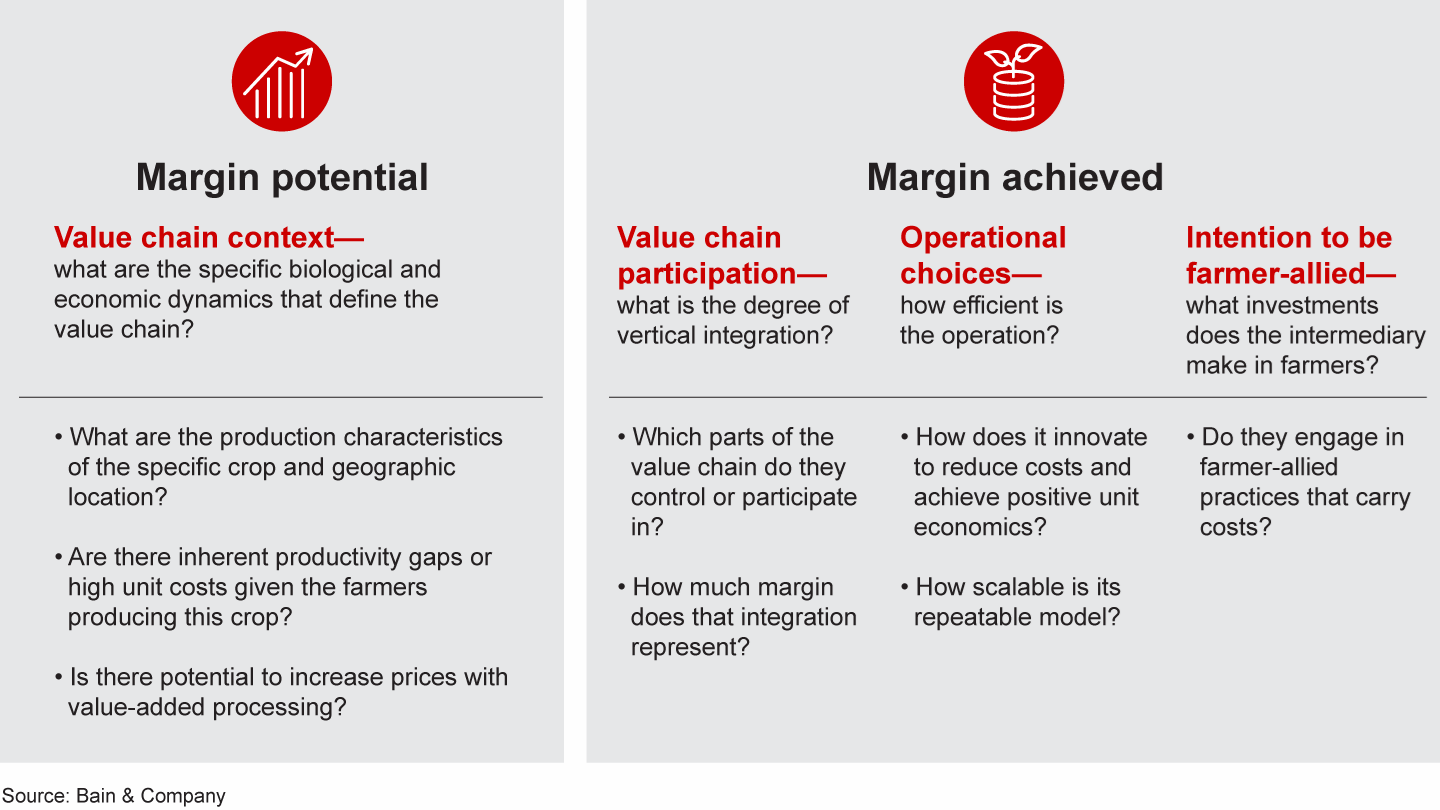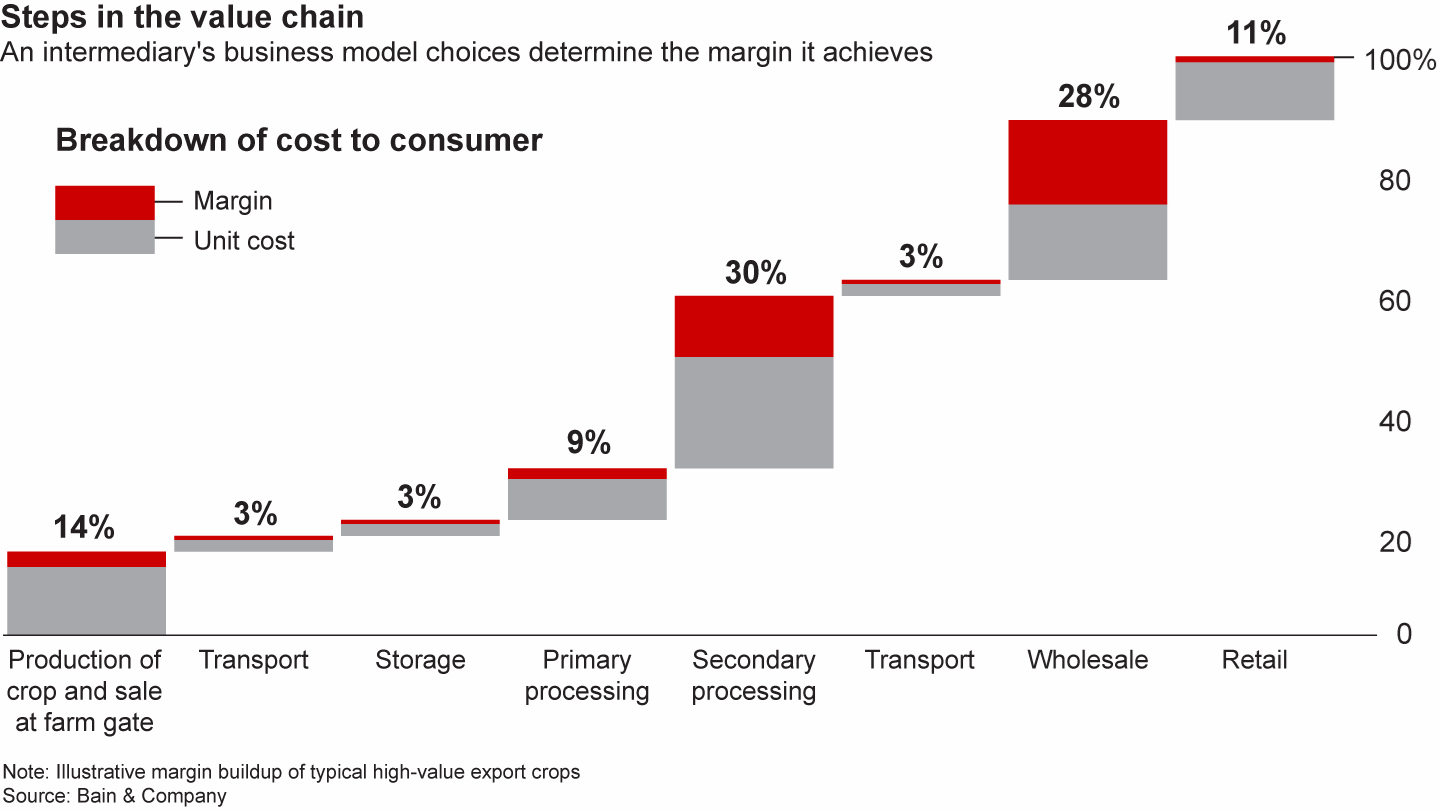Report

This article is Chapter 1 of Bain’s report on Africa’s critical agricultural intermediaries. Explore the contents of the report here or download the PDF to read the full report.
While historically agricultural development programs have focused disproportionately on improving farmer productivity and strengthening farmer organization, in recent years, these programs have recognized the importance of agricultural SMEs and increased efforts to strengthen them. This work, while well intentioned and often effective at a local level, has yet to move the needle at a systemic level for three reasons.
- It is too broad-based: Programs do not target specific value chains or specific types of enterprises within them, such as intermediaries.
- It is too piecemeal: Programs are too focused on discrete elements of the system. They may, for example, look at capital access without including the necessary upstream and downstream support, or concentrate on strengthening business or technical capacity without addressing capital gaps.
- It does not discriminate: There is a lack of rigor about which enterprises are targeted. Programs can often favor those with the greatest need, rather than those with the highest potential.
To date, efforts to support agriculture in sub-Saharan Africa have not unlocked the full economic potential of smallholder agriculture and its ability to transform local food systems.
The most telling sign that African agriculture is insufficiently developed is how little agricultural processing takes place in Africa. Post-farm-gate processing generates significant agricultural profits and economic impact in industrialized countries that capture more than 4.5 times the value per ton of agricultural product that developing countries do.
Many developed countries have policies that discourage processing in the African countries where products are grown—one example being the EU tariffs on processed cocoa. While quality standards for export are important, they can be expensive to meet and can discourage investing in processing.
By industrializing and commercializing agriculture, sub-Saharan Africa can capture more of the value added during aggregation, processing, distribution and logistics, packaging, and wholesaling and retailing. It can increase employment in the sector as well. This is critical if countries are to grow their agricultural sector faster than 6%, the rate the Comprehensive Africa Agriculture Development Programme has determined necessary to enable a country’s broader economic transformation.
Important trends converging today increase the urgency for this transformation but also make possible the “quiet revolution” of emerging agricultural intermediaries envisioned by the Alliance for a Green Revolution in Africa. Four are critical.
- Rising incomes and increasing urbanization: It is projected that the African food and agricultural market will reach $1 trillion by 2030. Urban centers already account for 40% of Africa’s population and more than half of food demand. By 2050, between 50% and 70% of Africa’s population is expected to live in cities. Consumers increasingly value food quality and safety, and a high-income, more urban population will demand a greater variety of foods with higher nutrition, in particular proteins and processed foods.
- A growing youth population demanding economic opportunities: Today, 60% of Africa’s population is under 25 years of age, with unemployment among 15- to 24-year-olds at 13% across sub-Saharan Africa and as high as 50% in South Africa. The continent’s population is expected to more than double by 2050, reaching more than 2 billion people. The risk of a large number of unemployed youth creating social instability is real and rising. Large-scale migration by this group stresses already overcrowded cities, and urbanization without industrialization (but instead a growing dependence on the services sector for jobs) does not provide a sufficient or sustainable path to rapid economic growth. Developing an attractive model of agriculture as a business, both on the farm and post–farm gate, can create job opportunities, especially for youth. Today, the average age of a smallholder farmer is around 50, so helping young people view farming as a viable entrepreneurial opportunity will also be important. Between 40% and 70% of the food costs of the urban consumer are incurred post–farm gate, so there will be economic opportunity downstream as well.
- Moving from climate change to climate crisis: Droughts and water shortages, more variable growing seasons, heat stress, increasing incidents of pestilence—all increase with climate change, and all strain the food system. Sub-Saharan Africa, where 95% of agriculture remains rain-fed, is particularly exposed to the increasing variability in rainfall patterns. As a result, by 2050, as tropical regions, including Africa, become less favorable for agriculture, yields are expected to drop by more than 10%. To cope, value chains will need to become more resilient through “sustainable intensification”—in other words, they must produce greater output from decreasing amounts of arable land, reduced water and a warming climate. This won’t be possible unless smallholder farmers get more support, including to minimize post-harvest losses, and are given incentives to adopt climate-smart agricultural practices and innovative ecological, genetic and other technologies. Intermediaries that link farmers to the rest of the agricultural value chain will be key to adoption.
- The promise of digital disruption: Supplying inputs, organizing farmers and transporting outputs will always require physical, on-the-ground activities. Digital technology, however, has opened up new ways of engaging with smallholder farmers at radically lower cost. New business models enable more efficient aggregation and purchasing of farmer output, and enterprises that previously could not profitably source from smallholder farmers can finally do so. Smartphone penetration in sub-Saharan Africa has been steadily increasing, with twice as many Africans expected to own a smartphone in 2025 as did in 2014. Innovations based on digital technology are also giving smallholder farmers much easier access to financing and information.
Farmer-allied intermediaries are uniquely positioned to address these converging trends.
Who are farmer-allied intermediaries?
Intermediaries are the enterprises that enable the flow of money and outputs between farmers and the market. Farmer-allied intermediaries strategically and intentionally source from smallholder farmers in a way that strengthens their capacity, improves their productivity and enhances their livelihoods.
- Crop choice: Traditionally, traders give farmers little insight into the market, supply or demand. But a farmer-allied intermediary will advise farmers on crop varieties with established market demand as well as on crop rotation and intercropping. In some cases, they may even try to convince whole communities or farmer organizations to switch to crops with greater market potential.
- Sustainable intensification: While traditional traders provide farmers with no production support, farmer-allied intermediaries often provide training to farmers and help them access financing, seeds, fertilizer, equipment and other inputs.
- Market access: Traditional traders purchase infrequently, opportunistically and in inconsistent quantities. Farmer-allied intermediaries, by contrast, commit to predictable and transparent pricing, and some enter into repeat or ongoing purchase agreements or agree to buy a given volume. They may pay farmers a premium price based on quality and often purchase more frequently, improving farmer cash flow. In addition, they may facilitate the setup of farmer/producer organizations and support farmers with storage and other logistics services that minimize post-harvest loss and help them sell at the best prices.
- Value chain participation: Some farmer-allied intermediaries increase farmer profits by facilitating primary processing on the farm or other activities that add value to the product before it leaves the farm gate.
Because farmer-allied intermediaries do much more for smallholder farmers, theirs is a higher-cost business model that is harder to scale profitably. A whole range of factors can affect any individual enterprise’s commercial viability, including the company’s life stage, how innovative it is, the quality of management and the intensity of competition. Two primary factors, however, structurally determine whether a farmer-allied intermediary can make money and how much: first, the value chain in which it participates; and second, its business model (see Figures 1, 2, and 3).




The first structural factor is the value chain in which the intermediary participates. Every crop is different, and the interplay between a crop’s biological and economic characteristics determines its margin potential.
The second structural factor determining an intermediary’s profitability is its business model— specifically, three sets of choices:
- Degree of vertical integration: Is it participating in more and higher-margin portions of the value chain?
- Operational choices: What is the degree of operational efficiency realized? To what extent is innovation (in core process and/or technology) lowering its cost to serve customers?
- Intention to be farmer allied: What investments does it make to support smallholder farmers?
To illustrate these dynamics, in chapter 2 we will profile three different case examples. Each intermediary has proven its commercial viability, having reached breakeven while sourcing from smallholder farmers and investing in their productivity. They have developed repeatable, scalable models that showcase entrepreneurial ingenuity in how they meet customer needs and achieve operational efficiencies. And all have attracted significant equity investment. Their crops, value chains and the broader context in which they operate differ, however, and so do the business models each has chosen, including the intention with which they invest in strengthening smallholder farmer capacity and the degree to which they do so. Those models shed light on the essential trade-offs between impact and financial returns, and illuminate the factors that influence those choices.
If not a roadmap for other crops and regions, these case studies at least outline what needs to be in place for this kind of system to really take off. They are exceptional success stories, and we hope in time to see many more.